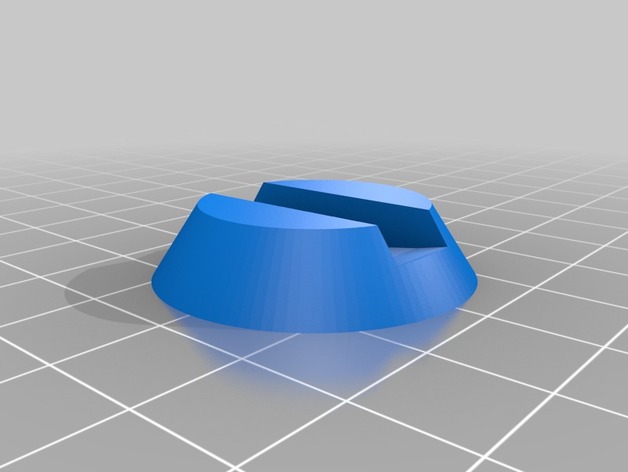
Gyroscope 3D
thingiverse
The organization I work for (Children’s Science Center of No Va) has a Summer Challenge! We have teamed up with AFCEA NOVA (Armed Forces Communications & Electronics Association) for a Walk, Run, Bike Challenge. Three military veterans from AFCEA NOVA will bicycle across the United States while raising money to donate to the Children’s Science Center. The trip will take three months and cover 4,200 miles. To support the Summer Challenge, and educate children and their families how to EXPLORE/INSPIRE/CREATE hands-on activities related to Bike Riding, exercise, and nutrition, I came up with this project-Gyroscope 3D. Participants will use TinkerCad or AutoDesk123Design or similar 3D design software and convert and import images, generate text, adding specific information and then manipulate individual objects to create a unique 3D model of toy Gyroscope. GYROSCOPE 3D PROJECT Introduction Bicycle physics is a broad and complex subject, perhaps more so than one can imagine. Although the number of components of a bicycle is small, the interaction between them and the dynamic principles involved, is complicated. This is especially true with regards to bicycle stability, which is the result of a complex dynamic interaction within the bike-rider system. Bicycles are inherently stable when riding. Even rider-less bicycles are stable if given enough forward velocity. Much effort has gone into analyzing the factors which make a bicycle stable. When analyzing bicycle stability it is common to use two parameters; the lean angle and steering angle of the bike. The lean angle is the left and right angle the bike frame makes with a vertical plane, and the steering angle is the angle the front wheel makes with the plane of the bike (containing the bike frame). Gyroscopic Effects On Bicycle Stability A common belief is that gyroscopic effects by themselves are what make a bike stable. This is actually not the case. Although gyroscopic effects do play a role, they are merely part of a much larger dynamic interaction taking place between the various bicycle components, which altogether is what ultimately makes a bicycle stable during riding. The design of a bicycle, and the configuration of the different components, have been optimized through the ages (largely through trial and error), to make it as stable as possible. The role of the gyroscopic effect in most bike designs is to help steer the front wheel into the direction of a lean. This phenomenon is called precession and the rate at which an object precesses is inversely proportional to its rate of spin. The slower a front wheel spins, the faster it will precess when the bike leans, and vice versa. The rear wheel is prevented from precessing as the front wheel does by friction of the tires on the ground, and so continues to lean as though it were not spinning at all. Hence gyroscopic forces do not provide any resistance to tipping. At low forward speeds, the precession of the front wheel is too quick, contributing to an uncontrolled bike’s tendency to oversteer, start to lean the other way and eventually oscillate and fall over. At high forward speeds, the precession is usually too slow, contributing to an uncontrolled bike’s tendency to understeer and eventually fall over without ever having reached the upright position. This instability is very slow, on the order of seconds, and is easy for most riders to counteract. Thus a fast bike may feel stable even though it is actually not self-stable and would fall over if it were uncontrolled. Print Settings Printer Brand: AutoDesk123Design Gyroscope 3D Model The Gyroscope 3D model can be created using TinkerCad or AutoDesk123Design software. The following steps are required to create the Gyroscope: 1. Import an image of a gyroscope into the software. 2. Convert the image into a 3D printable file. 3. Manipulate individual objects in the 3D model to create a unique Gyroscope design. Skills Learned The skills learned from this project include researching, importing and converting image files to 3D printable files, 3D modeling, project management. This project can be completed in a few hours or over the course of a few weeks (in shorter lessons) depending on time available and the skill level of your students. References/Credits The Bicycle Wheel gyroscope demonstration (http://wonders.physics.wisc.edu/bicycle-wheel-gyroscope.htm) http://www.real-world-physics-problems.com/bicycle-physics.html https://en.wikipedia.org/wiki/Bicycle_and_motorcycle_dynamics#Turning Bicycle Wheel Gyroscope (You Tube video demonstration) https://www.youtube.com/watch?v=8H98BgRzpOM Thingiverse Tag for Gyroscope Toy Gyroscope by alany Published on April 1, 2012 www.thingiverse.com/thing:20577 Creative Commons - Attribution
With this file you will be able to print Gyroscope 3D with your 3D printer. Click on the button and save the file on your computer to work, edit or customize your design. You can also find more 3D designs for printers on Gyroscope 3D.
